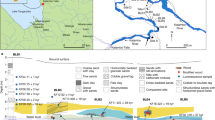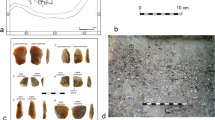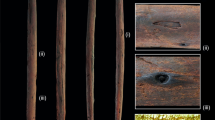Abstract
Little is known about the organic component of Lower and Middle Palaeolithic technologies, particular with respect to wooden tools1,2. Here I describe some wooden throwing spears about 400,000 years old that were discovered in 1995 at the Pleistocene site at Schöningen, Germany. They are thought to be the oldest complete hunting weapons so far discovered to have been used by humans. Found in association with stone tools and the butchered remains of more than ten horses, the spears strongly suggest that systematic hunting, involving foresight, planning and the use of appropriate technology, was part of the behavioural repertoire of pre-modern hominids. The use of sophisticated spears as early as the Middle Pleistocene may mean that many current theories on early human behaviour and culture must be revised.
This is a preview of subscription content, access via your institution
Access options
Subscribe to this journal
Receive 51 print issues and online access
$199.00 per year
only $3.90 per issue
Buy this article
- Purchase on Springer Link
- Instant access to full article PDF
Prices may be subject to local taxes which are calculated during checkout
Similar content being viewed by others
References
Oakley, K. P., Andrews, P., Keeley, L. H. & Clark, J. D. A reappraisal of the Clacton spearpoint. Proc. Prehist. Soc. 43, 13–30 (1977).
Thieme, H. & Veil, S. Neue Untersuchungen zum eemzeitlichen Elefanten-Jagdplatz Lehringen, Ldkr. Verden. Die Kunde N.F. 36, 11–58 (1985).
Thieme, H., Maier, R. & Urban, B. Archäologische Schwerpunktuntersuchungen im Helmstedter Braunkohlerevier (ASHB). -Zum Stand der Arbeiten 1983–1986. Archäol. Korrespondenzbl. 17, 445–462 (1987).
Thieme, H., Maier, R. & Urban, B. Neue Erkenntnisse zum urgeschichtlichen Siedlungsgeschehen. Archäol. Deutsch. 8(2), 26–30 (1992).
Urban, B., Thieme, H. & Elsner, H. Biostratigraphische, quartärgeologische und urgeschichtliche Befundeaus dem Tagebau ‘Schöningen’, Ldkr. Helmstedt. Z. Deutsch. Geol. Ges. 139, 123–154 (1988).
Urban, B., Elsner, H., Hölzer, A., Mania, D. & Albrecht, B. Eine eem- und frühweichselzeitliche Abfolge im Tagebau Schöningen, Landkreis Helmstedt. Eiszeit. Gegenw. 41, 85–99 (1991).
Urban, B., Lenhard, R., Mania, D. & Albrecht, B. Mittelpleistozän im Tagebau Schöningen, Ldkr. Helmstedt. Z. Deutsch. Geol. Ges. 142, 351–372 (1991).
Thieme, H. & Maier, R. Archäologische Ausgrabungen im Braimkohlentagebau Schöningen, Landkreis Helmstedt. (Hahnsche, Hannover, 1995).
Thieme, H. & Mania, D. ‘Schöningen 12’—ein mittelpleistozänes Interglazialvorkommen im Nordharzvorland mit paläolithischen Funden. Ethnogr.-Archaol. Z. 34, 610–619 (1993).
Urban, B. Mittelpleistozäne Interglaziale im Tagebau Schöningen. Ethnogr.-Archäol. Z. 34, 620–622 (1993).
Urban, B. in Archäologische Aus̀grabungen im Braunkohlentagebau Schöningen, Landkreis Helmstedt (eds Thieme, H. & Maier, R.) 44–56 (Hahnsche, Hannover, 1995).
Mania, D. Die Terrassen-Travertin-Sequenz von Bilzingsleben. Ein Beitrag zur Stratigraphie des Mittel- und Jungpleistozäns im Elbe-Saale-Gebiet. Ethnogr.-Archäol. Z. 34, 554–575 (1993).
Mania, D. in Archäologische Ausgrabungen im Braunkohlentagebau Schöningen, Landkreis Helmstedt (eds Thieme, H. & Maier, R.) 33–43 (Hahnsche, Hannover, 1995).
Mania, D. in The Earliest Occupation of Europe (eds Roebroeks, W. & van Kolfschoten, T.) 85–101 (University of Leiden, 1995).
Thieme, H., Mania, D., Urban, B. & van Kolfschoten, T. Schöningen (Nordharzvorland). Eine altpaläolithische Fundstelle aus dem mittleren Eiszeitalter. Archäol. Korrespondenzbl. 23, 147–163 (1993).
van Kolfschoten, T. Die Vertebraten des Interglazials von Schöningen 12. Ethnogr.-Archäol. Z. 34, 623–628 (1993).
van Kolfschoten, T. in Archäologische Ausgrabungen im Braunkohlentagebau Schöningen, Landkreis Helmstedt (eds Thieme, H. & Maier, R.) 85–94 (Hahnsche, Hannover, 1995).
Schoch, W. H. in Archäologische Ausgrabungen im Braunkohlentagebau Schöningen, Landkreis Helmstedt (eds Thieme, H. & Maier, R.) 73–84 (Hahnsche, Hannover, 1995).
Roberts, M. B., Stringer, C. B. & Parfitt, S. A. Nature 369, 311–313 (1994).
Roebroeks, W. & van Kolfschoten, T. in The Earliest Occupation of Europe (eds Roebroeks, W. & van Kolfschoten, T.) 297–315 (University of Leiden, 1995).
Nitecki, M. H. in The Evolution of Human Hunting (eds Nitecki,M. H. & Nitecki,D. V.) 1–9 (Plenum, New York, 1987).
Gamble, C. in The Pleistocene Old World. Regional Perspectives (ed. Soffer, O.) 81–98 (Plenum, New York, 1987).
Author information
Authors and Affiliations
Rights and permissions
About this article
Cite this article
Thieme, H. Lower Palaeolithic hunting spears from Germany. Nature 385, 807–810 (1997). https://doi.org/10.1038/385807a0
Received:
Accepted:
Issue Date:
DOI: https://doi.org/10.1038/385807a0
This article is cited by
-
Terminal ballistic analysis of impact fractures reveals the use of spearthrower 31 ky ago at Maisières-Canal, Belgium
Scientific Reports (2023)
-
Atlatl use equalizes female and male projectile weapon velocity
Scientific Reports (2023)
-
First direct evidence of lion hunting and the early use of a lion pelt by Neanderthals
Scientific Reports (2023)
-
Hominins built with wood 476,000 years ago
Nature (2023)
-
Evidence for the earliest structural use of wood at least 476,000 years ago
Nature (2023)
Comments
By submitting a comment you agree to abide by our Terms and Community Guidelines. If you find something abusive or that does not comply with our terms or guidelines please flag it as inappropriate.



